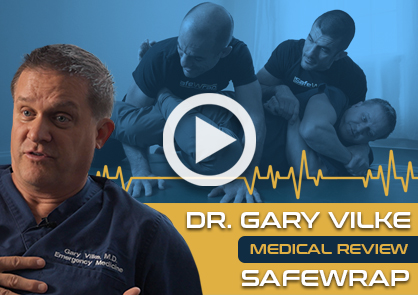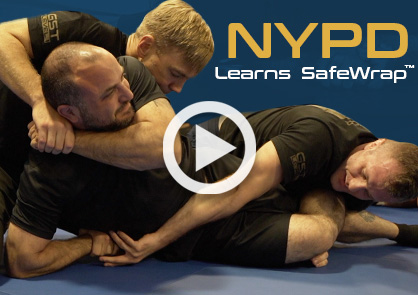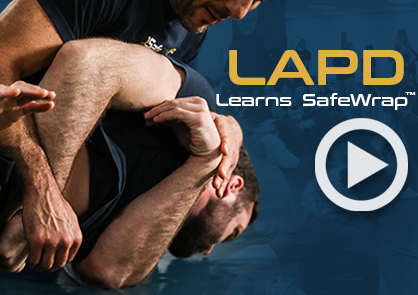SafeWrap is a proprietary system of restraint that is designed to maximize physical control while reducing the risk of injury to all parties involved in a use of force encounter.
The system was created by Gracie University in response to inquiries from healthcare institutions that needed a way to safely restrain aggressive, suicidal, or emotionally disturbed patients in hospitals. With patient safety as the top priority, it was imperative that the system utilize no joint locks, no choke holds, and no strikes. The system was specifically designed to minimize compression of the diaphragm to facilitate free breathing and reduce the potential of a panicked response in the restrained individual.


Due to the tremendous success of its application, it was quickly realized that SafeWrap had the potential to facilitate improved outcomes across various public and private sector organizations, while maintaining the public’s confidence in the frontline personnel of these organizations. Institutional applications include:
- Law Enforcement
- Corrections
- Probation/Parole
- Fire / EMS
- Healthcare
- Security
- Flight Attendants
- Elderly Care
- Education
- Childcare
...and the list goes on.


Traditional Restraint Challenges When de-escalation fails and staff members are required to physically restrain a person it can be unpredictable and dangerous, especially in cases where the staff members are poorly trained.
The most common method for two people to control a single, resistant subject is with prone restraint. While there are times when prone restraint is safe and advisable, when it is relied upon as the default method of restraint, it may give the subject being restrained certain tactical advantages that increase the risk of injury to the restrainers, including, but not limited to:
- Escape Power: When the subject is placed on their stomach, they are optimally positioned to push off the ground which may enable them to stand up and escape, or cause harm to others.
- Hidden Hands: In the prone position, the subject’s hands are often tightly buried beneath their body, making it very difficult for the restrainers to extract their arms (as is often required for handcuffing).
- Weapon Access: Because their hands are hidden, the subject may be able to access a weapon in their waistband, and by the time others become aware of the threat, it may be too late.


SafeWrap BenefitsWhen all members of an organization are SafeWrap certified, teamwork is optimized and the probability of injury to all parties is reduced to the absolute minimum. Here are some of the most significant benefits of the system:
Optimal Communication
With all staff members certified in the SafeWrap system, communication and teamwork are highly optimized.
Maximum Control
The simultaneous upper and lower body controls significantly reduce the subject's escape potential and their access to weapons.
Lateral Handcuffing
A simple procedure that allows for safe and effective application of handcuffs while keeping the subject on their side for the entire process.
Injury Reduction
By avoiding joint locks, chokes, and strikes, the system reduces liability by minimizing the chance of injury to all parties.
Dynamic De-Escalation
Full visibility of the subject’s face gives restrainers the opportunity to read emotional cues and communicate more effectively to enhance verbal de-escalation throughout the entire encounter.
Improved Medical Monitoring
Restrainers can more effectively monitor the subject for medical distress, and immediately render aid in case of an emergency.
Improved Public Relations
The gentle control and benign appearance of SafeWrap reduces the likelihood of public backlash after an incident.


The Complete System
In a 1-on-1 physical altercation, a person with years of martial arts training has a significant advantage over an untrained opponent. With SafeWrap, staff members can acquire an equal or greater tactical advantage with a small fraction of the training time due to the system’s simplicity and effectiveness.
In the SafeWrap end-user certification, staff members will learn the following skills in as little as 4-8 hands-on training hours per year:
Part 1: De-EscalationIn a moment of crisis, SafeWrap users are taught to use verbal de-escalation to reduce the intensity of the conflict and avoid physical intervention, if possible.
Part 2: SafeWrapIf verbal de-escalation is not possible or successful, the SafeWrap system is designed to restrain a person from virtually any position in an altercation with the lowest probability of injury.
Part 3: SafeDownWhile takedowns can be dangerous, the SafeDown reduces the risk of injury during descent to the absolute minimum through teamwork and technique.
Part 4: Restraint ProceduresFrom handcuffing to four-point restraints to restraint chairs, the SafeWrap system covers simple and effective methods for each industry-specific restraint procedure.
Part 5: Solo SurvivalIf de-escalation fails, and a staff member is attacked when they are alone, the solo survival skills will help them stay safe until help arrives and SafeWrap is initiated.


Instructor Certification
SafeWrap uses a train-the-trainer model. Once one or more members of an organization complete the SafeWrap instructor course, they are authorized to certify other members of their organization in the system.
Instructor certification can be accomplished in person or online using the Gracie University interactive online learning system and the corresponding video evaluation process.
There are currently three paths to in-person SafeWrap instructor certification:
- Standalone SafeWrap Instructor Certification (2 Days): The fastest way to achieve SafeWrap instructor certification is in the 2-day SafeWrap instructor course. No experience is necessary to participate and upon successful completion you will be certified to teach the complete system at your organization.
- Gracie Survival Tactics (GST) Level 2 Instructor Certification (5 Days): SafeWrap instructor certification can also be achieved by completing the GST Level 2 instructor course. This is ideal for law enforcement professionals since the complete GST curriculum covers so much more than SafeWrap. Click here to learn more about GST certification…
- Gracie Medical Defense (GMD) Instructor Certification (5 Days): For healthcare professionals (hospital clinical, security, fire/EMS, home health, care clinics, etc.) SafeWrap instructor certification is best achieved by completing the GMD instructor course, since this course also provides a complete workplace violence prevention program that prioritizes staff and patient safety. Click here to learn more about GMD certification…


SafeWrap Licensing
The SafeWrap system is patent pending worldwide and requires a license for institutional use. The benefit of the license is that it allows Gracie University to stipulate the terms of the system’s use, particularly as it pertains to minimum training requirements, to ensure that end-users are sufficiently trained in the system.
Gracie University is actively gathering data on this groundbreaking system’s effectiveness. For this reason, there is currently no cost for "early adopter" military, law enforcement, and first responder organizations to acquire a SafeWrap license provided certain requirements are met:
Instructor RequirementsThe organization must ensure that all SafeWrap training is conducted by an actively certified SafeWrap instructor.
Minimum Training RequirementsTo ensure that the end-users achieve optimal proficiency in the system’s application, the organization must adhere to the minimum SafeWrap training requirements (4-8 hours per year).
Refresher Video RequirementsTo maximize retention, each end-user is required to watch a short SafeWrap refresher video (approx. 15-minutes) once every three months. This can be done in group settings (i.e. during pre-shift briefings or "roll-call training"), or solo at a time that is convenient for each staff member.
Data & Record-Keeping RequirementsThe organization must keep accurate and detailed records regarding SafeWrap uses in the field and be willing to share these records with Gracie University upon request (provided agency policy permits the sharing of such records).


Once we gather sufficient data on the system’s effectiveness, the opportunity onboard at no cost will end. However, as a token of gratitude, all the agencies that onboard as “early adopters” will have opportunity to extend their free licenses for additional terms, even after the early adopter onboarding period has ended.
SafeWrap has the potential to save lives, but only if the minimum quality standards and training requirements are upheld. This is the primary purpose of the licensing agreement.
If a licensed agency gets involved in litigation surrounding the use of the SafeWrap system, Gracie University will provide expert witness support on the agency's behalf, at no cost other than the verifiable out-of-pocket expenses associated with providing such support (hotel, airfare, ground transportation, etc), provided the agency has active license in place and is in compliance with the terms of the licensing agreement.
To receive a copy of the complete licensing agreement for review and consideration by your organization, please click on the button below to submit the SafeWrap licensing inquiry. The inquiry is non-binding and only meant to provide you with additional information regarding the SafeWrap licensing requirements.
If your organization falls outside of the military/law enforcement/first responder category, please use the same licensing inquiry below to tell us more about your institution and one of our team members will respond with a customized proposal.
Frequently Asked Questions
SafeWrap is a proprietary system of restraint that is designed to maximize physical control while reducing the risk of injury to all parties involved in a use of force encounter. The system was created by Gracie University in response to inquiries from healthcare institutions that needed a way to safely restrain aggressive, suicidal, or emotionally disturbed patients in hospitals. With patient safety as the top priority, it was imperative that the system utilize no joint locks and no choke holds. The system was specifically designed to minimize compression of the diaphragm to facilitate breathing and reduce the potential of a panicked response in the restrained individual.
The SafeWrap system enables its users to restrain a subject in the lateral recumbent position. Using a series of new processes, body positions, and grip configurations, applied simultaneously by two people, not only are the system users able to reduce the likelihood of injury and escape, but they are also able to laterally transition into the application of restraint devices (i.e. handcuffs, four-point restraints, or other) using the newly invented processes.
By applying for intellectual property protection of the SafeWrap system, Gracie University can mandate minimum annual training requirements under license. This is particularly important in industries and organizations where staff members are severely undertrained to handle the violent physical encounters they often face in the course of their work.
The intellectual property (IP) rights associated with the SafeWrap system do not affect the personal practice of martial arts in any way, whatsoever.
Gracie University makes no claim to the Twisting Arm Control (aka “Gift Wrap”) position commonly used in Brazilian Jiu-Jitsu (BJJ), nor does it make any claim to any leg entanglements (aka “leg laces”) that are commonly used in grappling sports.
The IP rights afforded to Gracie University extend exclusively to the novel and inventive processes and components of the SafeWrap system with the objective of restraining an individual who poses a threat to themselves or others.
Furthermore, since the SafeWrap must be applied by at least two people against a single subject, there is no possibility that anyone engaging in regular 1-on-1 martial arts practice, BJJ or other, would be able to infringe on the IP associated with the SafeWrap system.
It does not. The IP rights associated with the SafeWrap system will have no effect on any processes or methods of subject restraint that existed prior to the creation of the SafeWrap system.
Any institution that has a method (or methods) of restraint, 2-on-1 or other, which they previously used or had success with, may continue to use those methods without any concern, whatsoever.
An institution only needs to obtain a SafeWrap license if it is specifically interested in adopting the SafeWrap system for the safety of its staff members and the people with whom they interact.
Unlike many existing restraint methods which are only reliable on the ground, the SafeWrap system is equally reliable whether the subject is on the ground or an elevated surface like a hospital stretcher, and it also has applications in other environments, including, but not limited to, seated applications.
Yes. If a licensed agency gets involved in litigation surrounding the use of the SafeWrap system, Gracie University will provide expert witness support on the agency's behalf, at no cost other than the verifiable out-of-pocket expenses associated with providing such support (hotel, airfare, ground transportation, etc), provided the agency has active license in place and is in compliance with the terms of the licensing agreement.
Although it may be relatively unknown in some circles, US Patent and Trademark law provides intellectual property protection for any new and useful improvements in four key categories:
- Process – “an act, or series of acts or steps”
- Machine – “a concrete thing, consisting of parts, or of certain devices and combination of devices”
- Manufacture – “an article produced from raw or prepared materials by giving these materials new forms, qualities, properties, or combinations, whether by hand labor or by machinery”
- Composition of Matter – “all compositions of two or more substances and all composite articles, whether they be the results of chemical union, or of mechanical mixture, or whether they be gases, fluids, powders or solids, for example
There have been countless patents granted for physical processes, and the SafeWrap lateral restraint system meets all the published requirements for such protection.
We are very proud to have created a new process of 2-on-1 restraint that will save lives all over the world; and we are grateful to live in a country where innovation is the bedrock of progress.
Learn more at https://www.uspto.gov/sites/default/files/101_step1_refresher.pdf